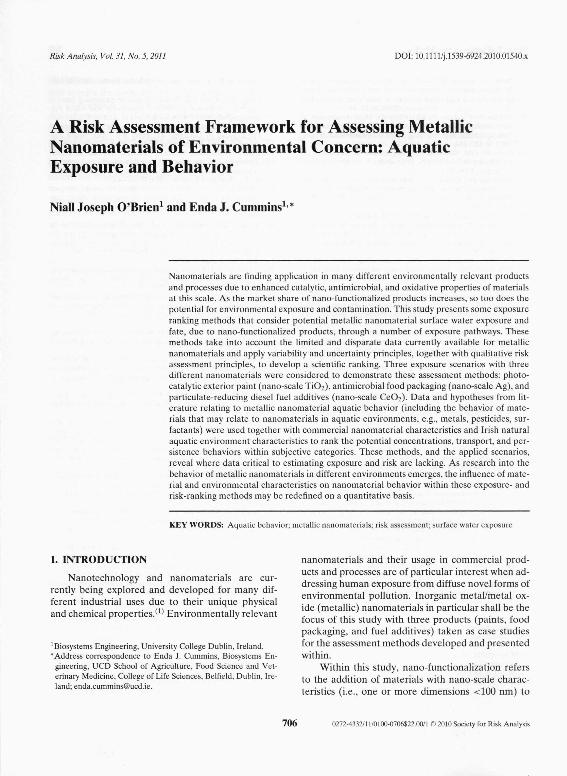A Risk assessment framework for assessing metallic nanomaterials of environmental concern : aquatic exposure and behavior

Contenido multimedia no disponible por derechos de autor o por acceso restringido. Contacte con la institución para más información.
| Tag | 1 | 2 | Value |
|---|---|---|---|
| LDR | 00000cab a2200000 4500 | ||
| 001 | MAP20110041861 | ||
| 003 | MAP | ||
| 005 | 20110915122037.0 | ||
| 008 | 110621e20110502usa|||p |0|||b|eng d | ||
| 040 | $aMAP$bspa$dMAP | ||
| 084 | $a935.3 | ||
| 100 | $0MAPA20110019594$aO'Brien, Niall Joseph | ||
| 245 | 0 | 2 | $aA Risk assessment framework for assessing metallic nanomaterials of environmental concern $b: aquatic exposure and behavior$cNiall Joseph O'brien, enda J. Cummins |
| 520 | $aNanomaterials are finding application in many different environmentally relevant products and processes due to enhanced catalytic, antimicrobial, and oxidative properties of materials at this scale. As the market share of nano-functionalized products increases, so too does the poten tial for environmental exposure and contamination. This study presents sorne exposure ranking methods that consider potential metallic nanomaterial surface water exposure and fate, due to nano-functionalized products, through a number of exposure pathways. These methods take into account the limited and disparate data currently available for metallic nanomaterials and apply variability and uncertainty principies, together with qualitative risk assessment principies, to develop a scientific ranking. Three exposure scenarios with three different nanomaterials were considered to demonstrate these assessment methods: photocatalytic exterior paint (nano-scale Ti02), antimicrobial food packaging (nano-scale Ag), and particulate-reducing diesel fuel additives (nano-scale Ce02 ). Data and hypotheses from literature relating to metallic nanomaterial aquatic behavior (including the behavior of materials that may relate to nanomaterials in aquatic environments, e.g., metals, pesticides, surfactants) were used together with commercial nanomaterial characteristics and Irish natural aquatic environment characteristics to rank the potential concentrations, transport, and persistence behaviors within subjective categories. These methods, and the applied scenarios, reveal where data critical to estimating exposure and risk are lacking. As research into the behavior of metallic nanomaterials in different environments emerges, the inftuence of material and environmental characteristics on nanomaterial behavior within these exposure- and risk-ranking methods may be redefined on a quantitative basis. | ||
| 650 | 1 | $0MAPA20080569709$aNanotecnología | |
| 650 | 1 | $0MAPA20100001066$aNanomateriales | |
| 650 | 1 | $0MAPA20080618223$aResistencia de materiales | |
| 650 | 1 | $0MAPA20080599560$aTratamiento del agua | |
| 650 | 1 | $0MAPA20080616045$aAspectos medioambientales | |
| 773 | 0 | $wMAP20077000345$tRisk analysis : an international journal$dMcLean, Virginia : Society for Risk Analysis, 1987-2015$x0272-4332$g02/05/2011 Tomo 31 Número 5 - 2011 , p. 706-726 |

